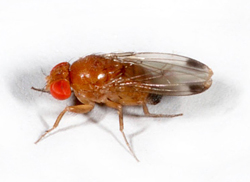Monitoring for SWD Can Provide Savings
Effective monitoring for spotted wing drosophila (SWD), especially early in the season, can provide substantial savings in treatment costs, according to Marco Valerio Rossi Stacconi, a research associate in the Department of Horticulture at Oregon State University.
“I know it is a lot of effort to do extensive monitoring, but it can help you save money and it will increase the efficacy of your (SWD) management,” Stacconi said. “It is important for getting an early warning and it is important throughout the season in order to establish when you have to treat and if you have to treat.”
Last year, in one example, a research consultant was able to help a grower save between 25 and 50 percent in pesticide costs through extensive monitoring, Stacconi said.
 |
Photo by Martin Hauser/ California Department of Food and Agriculture |
In a presentation at the Blueberry Field Day, July 17 in Aurora, Stacconi said most monitoring involves using homemade traps that attract adult flies with food attractants, such as apple cider vinegar or mixtures of red wine, vinegar and molasses. “There are a lot of different attractants that have more or less the same efficacy,” he said.
Growers also can purchase traps designed to capture SWD.
“It has been demonstrated that these have more or less the same efficacy as apple cider vinegar baits, but they are more specific toward the drosophila suzukii, so instead of getting tons of different species of flies in your traps, you will get less of the nontarget flies and it will be easier to check for drosophila suzukii,” he said.
In addition to trapping for adults, trapping for larva also can be important, Stacconi said. One method to do this involves what is known as the fruit-dunk method. It involves mixing one-half cup of salt in one gallon of water, dunking fruit for 15 minutes, and then counting the number of larvae that emerge from the fruit.
“It can be super easy and very fast, and it is also very important,” Stacconi said.
One alert Stacconi issued is for growers to be aware that when fruit ripens, trapping will not provide an accurate account of infestation levels, given that flies will be more attracted to the fruit than to the food attractant baits.
“You will still get flies in traps,” he said, “but it won’t give you accurate counts.”